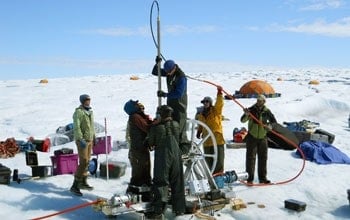Scientists’ understanding of how Greenland Ice Sheet melt water travels in passages along the bedrock below fails to account for some key processes. This, in turn may be affecting their assessment of how ice sheets respond to climate change, according to newly published research funded by the National Science Foundation (NSF).
In a paper published in this week’s edition of Science magazine, researchers discuss a novel hot-water drilling technique that they have developed and deployed to better understand the processes that take place beneath the ice sheet.
Their work suggests that the assumption that water drainage under the ice sheet is comparable to that of mountain glaciers may well overlook important processes that guide development of the drainage system beneath the larger ice sheet.
“This new view affects our understanding of how the ice sheet will accommodate changes in surface melt and how ice sheets interact with groundwater systems,” said Joel Harper, a geoscientist at the University of Montana and the principal investigator on the project. “It also demonstrates the kinds of research required to fully understand the Greenland ice sheet’s response to past, present or future climate conditions.”
Evolution of this water-routing network is important to assessing how ice sheet dynamics may respond to potential future warming. Faster flow increases ice discharge to the oceans and also draws more ice to lower elevations where melt rates are higher, thereby accelerating to global sea-level rise.
Each summer surface meltwater finds a way through hundreds and even thousands of meters of cold ice, before it travels through a subglacial drainage network to the ice edge. This plumbing system at the interface of ice and bedrock constantly adjusts and changes in response to input variations from the surface. The capacity of the drainage network to transport the meltwater affects seasonal accelerations in ice sheet motion by modulating the speed at which the ice slides over the bed.
Until recently, the logistical difficulties of accessing the Greenland bedrock have severely limited scientists’ ability to observe and fully understand this forcing and response. Large-scale ice coring projects collect ice samples and seek out some of the thickest parts of the ice sheet to attain the longest paleoclimate records. These are generally complex and multi-year projects, which produce a single borehole down to the bed.
But a team headed by Harper has successfully deployed a drill, developed and designed by Neil Humphrey, of the University of Wyoming, that allowed them to drill 23 holes over three research seasons to the ice sheet bed in ice up to a half-mile thick.
The small team, consisting of Harper and Humphrey, two doctoral students, two graduate students and two undergraduates, flew equipment tens of kilometers inland from the ice-sheet edge, where they camped for up to four weeks at a time while drilling.
The drill pumped cold surface water through a series of heaters and high-pressure pumps to melt a hole through the ice sheet at 100 meters per hour. The fast drilling and portable nature of the drill, which six people could pick up and carry, allowed the team to drill multiple holes at each site.
The results of their drilling indicates that key aspects of the theories developed from observations on smaller, more accessible mountain glaciers are not transferable to Greenland. Mountain glacier geometry generally stimulates the rapid development of water-draining conduits by melting back the overlying ice roof. In contrast, the thick ice and relatively flat surface of Greenland does not promote such fast growth of the basal drainage system by melting open water passages.
The research team surmises that, away from the ice-sheet edge, a key ingredient in triggering development of the basal drainage network may be opening of water-routing passageways along the underlying rock by sliding of the ice over bedrock. The researchers tested their findings from the borehole measurements with numerical models for simulating water and ice flow at the ice sheet’s bed.
“The team has taken this project all the way from engineering design to successful deployment to important new results that further our understanding of basic processes involved in the Greenland Ice Sheet’s role in climate change,” said Hedy Edmonds, a program manager in NSF’s Arctic sciences section.


